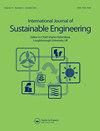Comparative life cycle assessment of refrigeration systems for food cooling: eco-design actions towards machines with natural refrigerants
IF 3.6
Q3 GREEN & SUSTAINABLE SCIENCE & TECHNOLOGY
International Journal of Sustainable Engineering
Pub Date : 2021-08-29
DOI:10.1080/19397038.2021.1970274
引用次数: 6
Abstract
ABSTRACT Refrigeration applications is responsible for approximately 17% of the total electricity and around 8% of greenhouse gas emissions. This study presents a comparative life cycle assessment between two refrigeration systems, the first operating with a traditional fluid and the second with a natural refrigerant. The analysis was performed in accordance with international standards ISO 14040/14044 and adopted the attributional life cycle assessment approach. The functional unit was: ‘the storage of meat products, at the temperature of 0°C for a lifetime of 10 years, in refrigerating cells of a medium city supermarket’. Three different scenarios were analysed to investigate the effect of the energy mix in relation to the use of the machines. Results highlight how the choice of the refrigerating fluid has a higher effect on the environmental performances of the machine with a reduction of approximately 10% in a whole life cycle. Scenario analysis shows how the use of such machines in different countries allows a significant reduction of environmental impacts mostly related to the use phase. Eco-design actions were listed and connected with environmental hot spots specifying the life cycle phases and the environmental indicators involved.食品冷却制冷系统的比较生命周期评估:采用天然制冷剂的机器的生态设计行动
摘要制冷应用约占总电力的17%,温室气体排放量约占8%。这项研究对两种制冷系统的生命周期进行了比较评估,第一种使用传统流体运行,第二种使用天然制冷剂运行。根据国际标准ISO 14040/14044进行分析,并采用归因生命周期评估方法。功能单元是:“在中等城市超市的冷藏室中,在0°C的温度下储存肉制品,使用寿命为10年”。分析了三种不同的情景,以调查与机器使用相关的能源组合的影响。结果突出表明,制冷液的选择对机器的环境性能有更高的影响,在整个生命周期内可减少约10%。情景分析显示了在不同国家使用此类机器如何显著减少主要与使用阶段有关的环境影响。列出了生态设计行动,并将其与环境热点联系起来,具体说明了生命周期阶段和所涉及的环境指标。
本文章由计算机程序翻译,如有差异,请以英文原文为准。
求助全文
约1分钟内获得全文
求助全文
来源期刊

International Journal of Sustainable Engineering
GREEN & SUSTAINABLE SCIENCE & TECHNOLOGY-
CiteScore
7.70
自引率
0.00%
发文量
19
 求助内容:
求助内容: 应助结果提醒方式:
应助结果提醒方式:


